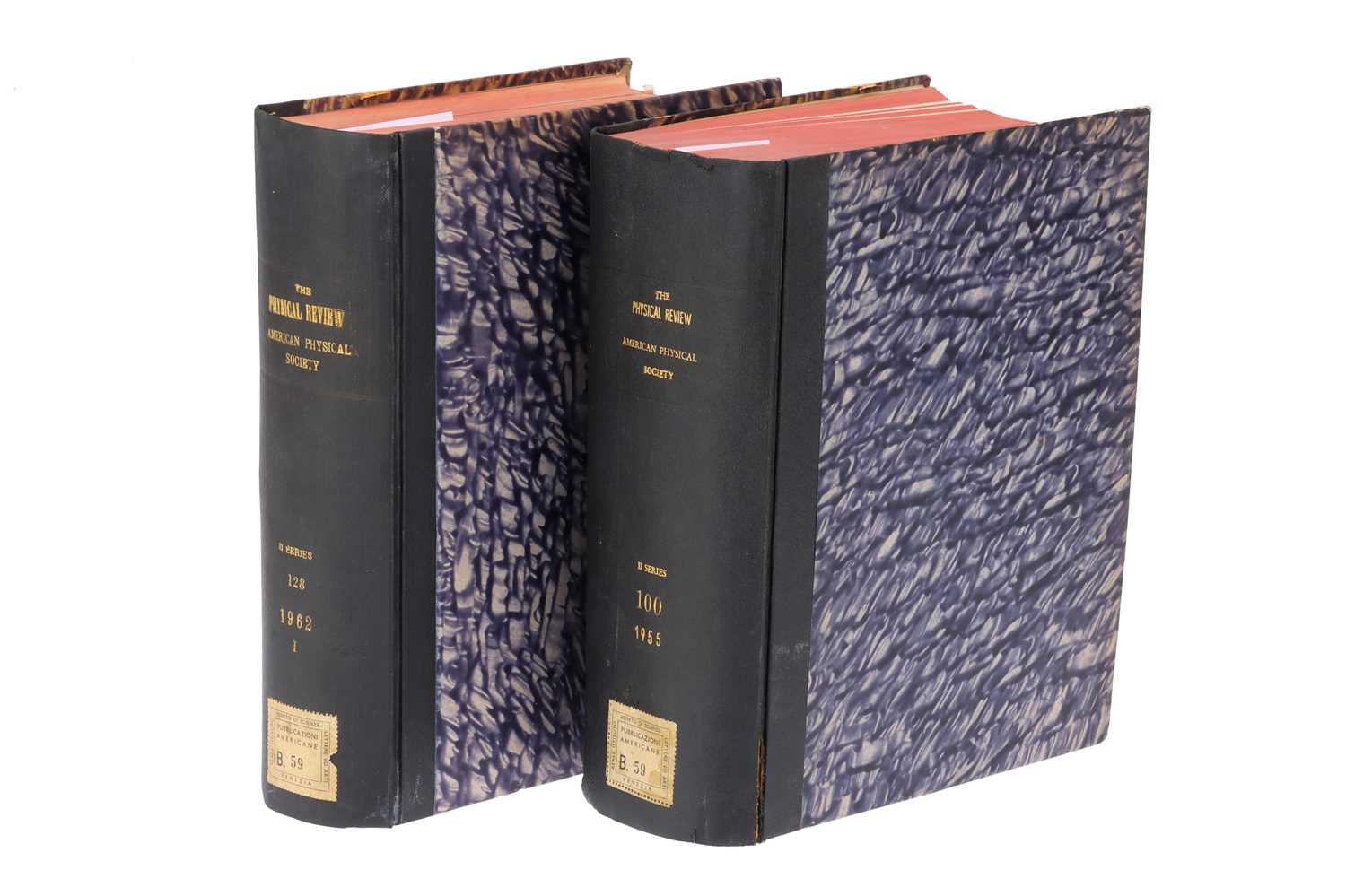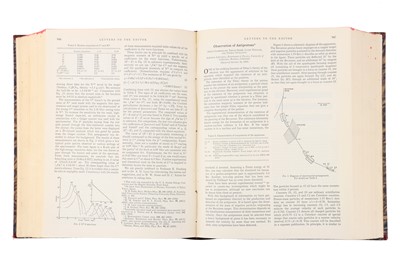24th May, 2023 12:00
Fine Instruments of Science, Medicine and Books
Chamberlin & Serge, Discovery of the Antiproton, Physical Review 1955
Physical Review, vol.100, no.3 Novemer 1955, bound journal, faux leather spine with blue marbled boards, Owen Chamberlin, Emelio Serge, Clyde Wiegang, and Thomas Ypsilantis' letter 'Observations of Antiprotons' [p.947 - p.950]
Physical Review, vol.128 no.2, October 15, 1962, bound journal, faux leather spine with blue marbled boards, Tommy Elioff, Lewis Agnew, Owen Chamberlin, Herbert M. Steiner, Clyde Wiegang, and Thomas Ypsilantis' paper 'Antiproton-Nucleon Cross Sections from 0.5 to 1.0 BeV' [p.869 - p.884]
The discovery of the antiproton by Emilio Segrè and Owen Chamberlain at the University of California, Berkeley, was a groundbreaking achievement that earned them the 1959 Nobel Prize in Physics. Their discovery, which was first reported in Physical Review in 1955, was a significant step forward in our understanding of the fundamental structure of matter.
The concept of the antiproton, an antimatter particle with the same mass as a proton but with opposite charge, had been proposed by Paul Dirac in the 1920s as a natural extension of his theory of antimatter. However, the existence of the antiproton had not been experimentally confirmed until Segrè and Chamberlain's discovery.
The discovery was made possible by the invention of the Bevatron, a particle accelerator that was capable of producing high-energy proton beams. Segrè and Chamberlain used the Bevatron to accelerate protons to energies of several billion electron volts, which they then directed onto a copper target.
As the protons collided with the copper atoms, some of them produced pairs of particles, including antiprotons. However, the antiprotons were highly unstable and quickly annihilated when they came into contact with matter. To detect the antiprotons, Segrè and Chamberlain used a complex apparatus that included a magnetic field and detectors to measure the particles' energy and momentum.
After months of painstaking experimentation, Segrè and Chamberlain finally succeeded in detecting the first antiproton in 1955. Their discovery was a major breakthrough in particle physics and opened up new avenues for research into the nature of matter and antimatter.
The discovery of the antiproton also had important implications for cosmology, as it provided evidence that the universe was created with equal amounts of matter and antimatter. However, the question of why the universe is dominated by matter remains one of the most significant mysteries in physics.
Segrè and Chamberlain's discovery of the antiproton was a remarkable achievement that revolutionized our understanding of the fundamental structure of matter. Their work laid the groundwork for further research into antimatter and opened up new avenues for exploration in particle physics and cosmology. Today, the study of antimatter continues to be an active area of research, with potential applications in fields such as medical imaging and cancer treatment.
Physical Review, vol.100, no.3 Novemer 1955, bound journal, faux leather spine with blue marbled boards, Owen Chamberlin, Emelio Serge, Clyde Wiegang, and Thomas Ypsilantis' letter 'Observations of Antiprotons' [p.947 - p.950]
Physical Review, vol.128 no.2, October 15, 1962, bound journal, faux leather spine with blue marbled boards, Tommy Elioff, Lewis Agnew, Owen Chamberlin, Herbert M. Steiner, Clyde Wiegang, and Thomas Ypsilantis' paper 'Antiproton-Nucleon Cross Sections from 0.5 to 1.0 BeV' [p.869 - p.884]
The discovery of the antiproton by Emilio Segrè and Owen Chamberlain at the University of California, Berkeley, was a groundbreaking achievement that earned them the 1959 Nobel Prize in Physics. Their discovery, which was first reported in Physical Review in 1955, was a significant step forward in our understanding of the fundamental structure of matter.
The concept of the antiproton, an antimatter particle with the same mass as a proton but with opposite charge, had been proposed by Paul Dirac in the 1920s as a natural extension of his theory of antimatter. However, the existence of the antiproton had not been experimentally confirmed until Segrè and Chamberlain's discovery.
The discovery was made possible by the invention of the Bevatron, a particle accelerator that was capable of producing high-energy proton beams. Segrè and Chamberlain used the Bevatron to accelerate protons to energies of several billion electron volts, which they then directed onto a copper target.
As the protons collided with the copper atoms, some of them produced pairs of particles, including antiprotons. However, the antiprotons were highly unstable and quickly annihilated when they came into contact with matter. To detect the antiprotons, Segrè and Chamberlain used a complex apparatus that included a magnetic field and detectors to measure the particles' energy and momentum.
After months of painstaking experimentation, Segrè and Chamberlain finally succeeded in detecting the first antiproton in 1955. Their discovery was a major breakthrough in particle physics and opened up new avenues for research into the nature of matter and antimatter.
The discovery of the antiproton also had important implications for cosmology, as it provided evidence that the universe was created with equal amounts of matter and antimatter. However, the question of why the universe is dominated by matter remains one of the most significant mysteries in physics.
Segrè and Chamberlain's discovery of the antiproton was a remarkable achievement that revolutionized our understanding of the fundamental structure of matter. Their work laid the groundwork for further research into antimatter and opened up new avenues for exploration in particle physics and cosmology. Today, the study of antimatter continues to be an active area of research, with potential applications in fields such as medical imaging and cancer treatment.



